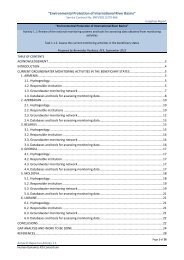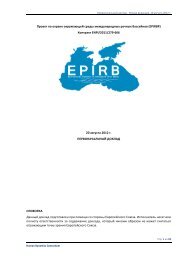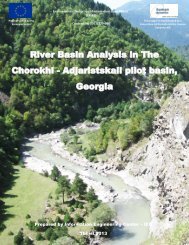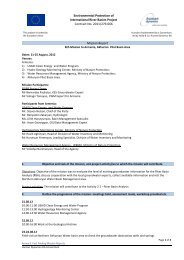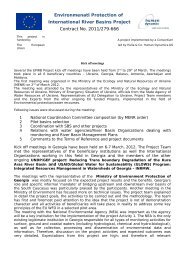Nokia Standard Document Template - Environmental Protection of ...
Nokia Standard Document Template - Environmental Protection of ...
Nokia Standard Document Template - Environmental Protection of ...
- No tags were found...
You also want an ePaper? Increase the reach of your titles
YUMPU automatically turns print PDFs into web optimized ePapers that Google loves.
4th Mission Report _KE3_Jan –Feb 2013owing to the high turnover <strong>of</strong> staff, lack <strong>of</strong> calibration standards and specific training, the Department wasstruggling to obtain reliable results. On inspection the following issues were noted:1) Sampling BottlesThe sampling bottles were too small (160ml), ideally the bottles should be 2000ml amber glass withground glass tops or caps with Teflon inserts. These smaller bottles were used because procuringextraction solvents (pentane or hexane) was very difficult in Armenia owing to import problems.Therefore it was decided that by using smaller bottles then less solvent would be required. Whilst thisseems logical, it should be noted that the extraction is also an important concentrating technique. If thesample is too small, then insufficient concentrations <strong>of</strong> OCPs can be extracted and therefore impossibleto be detected by GLC analysis. It is very unlikely that such small samples would be sufficient to obtainthe required limit <strong>of</strong> detection (LOD). It was recommended that the sampling bottles were replaced bylarger 2000ml amber glass bottles with ground glass tops or caps with Teflon inserts.2) Calibration <strong>Standard</strong>sThere was a serious problem owing to the lack <strong>of</strong> proper calibration standards for all the organic analysis.The situation for each type <strong>of</strong> analysis was as follows:i) There were no calibration standards for the OCPs. The current analyst relied on previous calibrationsobtained in 2006 by their predecessors. Chromatographic peaks and recoveries can change from day today; therefore using calibration data that is 7 years old is unacceptable. To resolve this, fresh standardsshould be used to prepare new acceptable calibration standards. It was recommended that the Projectobtains these training materials so that the KE3 could complete this vital training.ii) There was one old standard mix (23 parameters) for VOC analysis <strong>of</strong> limited amount and was out <strong>of</strong>date.iii) There were only 3 contaminated old standards for the aromatic hydrocarbons analysis.The staff had been using these very poor standards, which were inadequate for quantification to obtaincredible results for the WFD. It was recommended that Project tries to at least obtain the OCP standardsto complete this urgent training.3) Instrumental s<strong>of</strong>tware:Each <strong>of</strong> the four GLCs had dedicated operating s<strong>of</strong>tware. The staff had not been adequately trained onthese, which limited the application <strong>of</strong> the s<strong>of</strong>tware. However the important elements <strong>of</strong> the analysiscould be easily obtained from the s<strong>of</strong>tware such as:i.) The retention times.ii.) The areas and heights <strong>of</strong> the integrated peaks.iii.) The operational conditions <strong>of</strong> the GLC.iv.) The identification <strong>of</strong> the peaks.These elements were sufficient to carry out qualitative and quantitative analysis by using simplecalibration graphs and by processing this data either manually or with Excel Spreadsheets.An introductory training workshop on GLC analysis was presented by the KE3 to ensure the staff had aclearer understanding on how the results could be calculated. It was recommended that the staff couldalso continue to improve their knowledge <strong>of</strong> the system by further investigating the s<strong>of</strong>tware together. InPage 4 <strong>of</strong> 36




